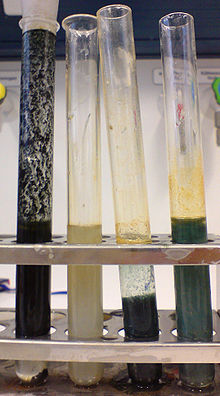രസതന്ത്രം
സംക്രമണമൂലകങ്ങളുടെ നിറങ്ങൾName | Formula | Color | Picture |
CuSO4 | White | ||
Copper(II) sulfate pentahydrate | CuSO4 · 5H2O | Blue | |
CoCl2 | Deep blue | ||
Cobalt(II) chloride hexahydrate | CoCl2 · 6H2O | Deep magenta | |
Manganese(II) chloride tetrahydrate | MnCl2 · 4H2O | Pink | |
Copper(II) chloride dihydrate | CuCl2 · 2H2O | Blue-green | |
Nickel(II) chloride hexahydrate | NiCl2 · 6H2O | Green | |
PbI2 | Yellow |
Ions in aqueous solution
Name | Formula | Color |
Alkali metals | M+ | None |
Alkaline earth metals | M2+ | None |
Scandium(III) | Sc3+ | None |
Titanium(III) | Ti3+ | Violet |
Titanyl | TiO2+ | None |
Vanadium(II) | V2+ | Lavender |
Vanadium(III) | V3+ | Dark grey/green |
Vanadyl | VO2+ | Blue |
Pervanadyl | VO2+ | Yellow |
Metavanadate | VO3- | None |
Orthovanadate | VO43- | None |
Chromium(III) | Cr3+ | Blue-green |
Chromate | CrO4 2- | Colorless or Yellow(sometimes) |
Dichromate | Cr2O72- | Orange |
Manganese(II) | Mn2+ | Colourless |
Manganate(VII) (Permanganate) | MnO4- | Deep violet |
Manganate(VI) | MnO42- | Dark green |
Manganate(V) | MnO43- | Deep blue |
Iron(II) | Fe2+ | Light blue |
Iron(III) | Fe3+ | Yellow/brown |
Cobalt(II) | Co2+ | Pink |
Cobalt-ammonium complex | Co(NH3)63+ | Yellow/orange |
Nickel(II) | Ni2+ | Light green |
Nickel-ammonium complex | Ni(NH3)62+ | Lavender/blue |
Copper(II) | Cu 2+ | Blue |
Copper-ammonium complex | Cu(NH3)42+ | Royal Blue |
Tetrachloro-copper complex | CuCl42- | Yellow/green |
Zinc(II) | Zn2+ | Bluish-white |
Silver | Ag+ | None |
1. Sc - scandium salts, such as the chloride, ScCl3, are colourless and are not typical of transition metals
2. Ti - titanium(III) chloride, TiCl3, is purple
3. V - vanadium(III) chloride, VCl3, is green
4. Cr - chromium(III) sulphate, Cr2(SO4)3, is dark green (chromate(VI) salts are yellow, dichromate(VI) salts are orange)
5. Mn - manganese compound - potassium manganate(VII), KMnO4, is purple (manganese(II) salts eg MnCl2 are pale pink)
6. Fe - iron(III) chloride, FeCl3, is yellow-orange-brown.
o Iron(II) compounds are usually light green and iron(III) compounds orange/brown.
7. Co - cobalt sulphate, CoSO4, is pinkish
8. Ni - nickel chloride, NiCl2, is green
9. Cu - copper(II) sulphate, CuSO4, is blue.
o Most common copper compounds are blue in their crystals or solution and sometimes green.
o The blue aqueous copper ion, Cu2+(aq), actually has a more complicated structure:
§ *[Cu(H2O)6]2+(aq) and when excess ammonia solution is added,
§ after the initial gelatinous blue copper(II) hydroxide precipitate is formed, Cu(OH)2,
§ it dissolves to form the deep royal blue ion: *[Cu(H2O)2(NH3)4]2+(aq).
§ *are called complex ions and when coloured are typical of transition metal chemistry.
o Copper(II) oxide, CuO, black insoluble solid, readily dissolving in acids to give soluble blue salts e.g.
§ copper(II) sulphate, CuSO4, from dilute sulphuric acid,
§ copper(II) nitrate, Cu(NO3)2, from dilute nitric acid
§ and greeny-blue copper(II) chloride, CuCl2, from dilute hydrochloric acid.
o Copper(II) hydroxide, Cu(OH)2, blue gelatinous precipitate formed when alkali added to copper salt solutions.
o Copper(II) carbonate, CuCO3, is turquoise-green insoluble solid, readily dissolving in acids, evolving carbon dioxide, to give soluble blue salts (see above)
o Copper's valency or combining power is usually two e.g. compounds containing the Cu2+ ion.
§ However there are copper(I) compounds where the valency is one.
§ This variable valency, hence compounds of the same elements, but with different formulae, is typical of transition metal compounds e.g.
§ copper(I) oxide, Cu2O, an insoluble red-brown solid (CuO is black),
§ or copper(I) sulphate, Cu2SO4, a white solid.
10. Zn - zinc salts such as zinc sulphate, ZnSO4, are usually colourless and are not typical of transition metals.
Salts of Cu+ are reasonably common, often water insoluble and
mostly white in color. However, Cu + is readily oxidized to Cu2+ in most aqueous solution
conditions. So, Cu2+ salts are much more common than the Cu+ salts. Many of these salts are
water soluble and highly colored
1)ചാള്സ് നിയമം
 |
| charles the great scientist |
2)ബോയില് നിയമം
 |
| Robert Boyle Father of Modern Science |
SSLC 2011 FEB PHYSICS MODEL QUESTION 14-ANSWER :A DISCUSSION WITH PHOTOS&VIDEO
 |
| Q. 14.ചിത്രം1ൽ ബൾബുകളുടെ(A&B) പ്രകാശം നോക്കൂ |
 |
| Q .14 ചിത്രം2ൽ Bയുടെ പ്രകാശത്തിന്റെ മാറ്റം നോക്കൂ.A&Cബൾബുകളുടെ പ്രകാശമാറ്റംകാണാൻ താഴെത്തെഫോട്ടൊ കാണൂ |
 |
| Q. 14ചിത്രം2ൽ A&Cബൾബുകൾ മങ്ങി കത്തുന്നു |
ഇനി ഈ വിഡിയോ കാണൂ







